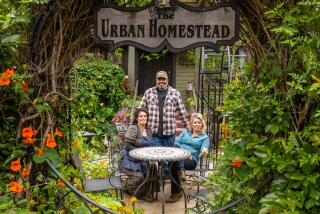Why grow your own mushrooms? Because they’re delicious
- Share via
It all started with a bag of mushroom compost bought from Cliff Kane, a grower who sells shiitake and blue oyster mushrooms at the Echo Park Farmers’ Market.
I had planned on using it for my own compost pile, but Kane said if it was kept moist then it was possible another flush of mushrooms would emerge in a few weeks. Intrigued, I hung the bag in the shade of a tree and watered it down every other day. And within a month there were indeed a half dozen palm-sized oyster mushrooms poking out of the bag.
They were delicious, more flavorful than any fungi I’d ever had. (Unlike many fruits, with mushrooms the shortest time from patch to plate, the better.)
Once mushrooms were something foragers gathered or agribusiness farmed. You never grew your own unless you had a seriously damp, shady patch in your yard.
That’s changed. Now, even Home Depot has a $12.98 Mushroom Mini Farm.
I decided to put one of these kits to the test.
I chose a user-friendly Shiitake Mushroom Patch sold for $26 by Fungi Perfecti, the Olympia, Wash., company run by Paul Stamets, a mycologist -- that’s a fungi expert -- known for his popular TED talk, “6 Ways Mushrooms Can Save the World,” which has more than 3.5 million views.
If properly maintained, the Patch kit promises to produce up to three pounds of mushrooms over four months. It comes with a food-grade perforated plastic tent that helps to control the humidity around the patch, and since fungi are around 90% water, the balance between too wet and not moist enough is important.
The most common mistake first-time growers make is over-watering. Rather than mist the plant or the patch, you should spritz the air within the tent.
“Mushrooms need air and if you water too much, you’ll drown them and they don’t produce as well,” said Tristan Woodsmith of Fungi Perfecti.
Direct sunlight is another thing to be avoided. Temperature-wise, if you’re comfortable, the mushrooms are too.
The kit arrived with a birthdate stamp, giving its age.
It was a table-top bonsai I could eat.
It wasn’t much to look at, though. A white-brown mini-stump of sterilized sawdust and wood chips, pimpled with brownish lumps that would almost overnight become edible mushrooms, the result of the mycelium network that lived within.
My only job was to keep it going until it was spent, all eaten.
Grilled briefly and with no salt or oil, the mushrooms were scrumptious, exploding with juicy mushroom umami.
Twitter: @latimeshome
ALSO:
The time to fight those weeds is now. Here’s how to do it.
9 tips for growing from seed (c’mon — you can do it!)
THE GLOBAL GARDEN: Planting ideas for every season
How the drought led an L.A. artist to create this stunning container garden






